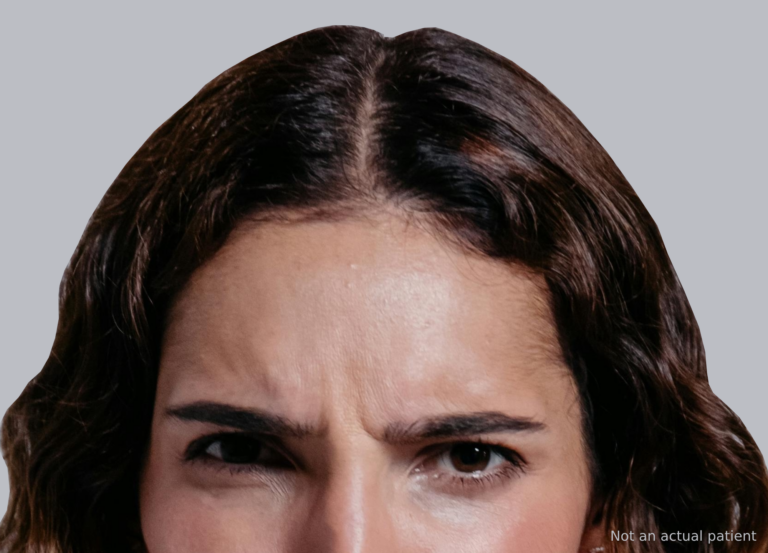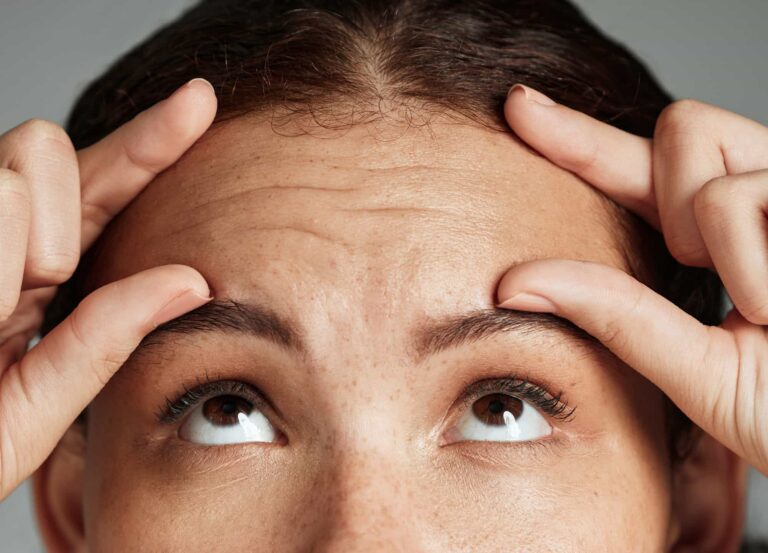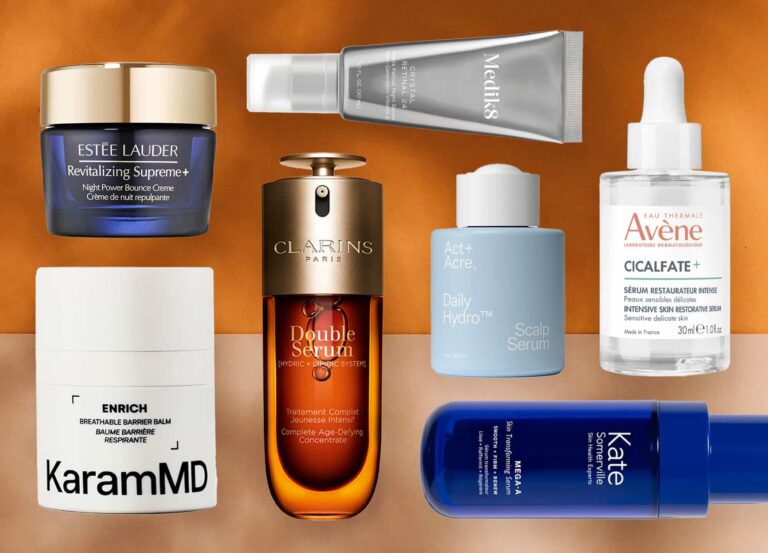“There’s something wrong with my skin.” This is not a sentiment I’d ever uttered until about a month ago, when I started repeating those five words to anyone within earshot. My forehead just wasn’t the same; the skin was crepey and incredibly dry yet had crops of tiny pimples. At first, I blamed the switch from spring to summer (and the subsequent rotation of skin-care products), but when my skin remained different, I took a deeper dive into my regimen in order to find the culprit. I realized that over the course of eight months, I’d made only one noteworthy change to how I care for my skin: I had started getting Botox injections, to tackle the ever-deepening rows on my forehead.
“Neurotoxins work by preventing nerves from signaling your muscles to contract in the local areas that have been treated,” explains Dr. Joshua Zeichner, a board-certified dermatologist in New York City. “If the muscles don’t contract, then the overlying skin does not fold or wrinkle.” During one of my many forehead-examining sessions, I posed a hypothesis: just as neurotoxins “freeze” the muscle that makes a wrinkle, maybe they can also restrict the muscle responsible for sebum output. Could Botox be limiting my forehead’s ability to produce oil?
“If you have or are experiencing dryness, you are not imagining it,” says Dr. Ava Shamban, a board-certified dermatologist in Beverly Hills, California. “Intradermally, neuromodulators can target other muscles in the same way, including our arrector pili muscle [AMP].” According to Dr. Shamban, the AMP is a small band of smooth muscle at the base of our hair follicles; it helps control pore size and the amount of sebum that is released, both within our cells and to the skin’s surface, for lubrication.
A variety of studies show that neurotoxins can, in fact, be used to control oil output and pore size, and it’s these benefits that inspired the concept of “Botox facials.” Botox facials, or micro-neurotoxin treatments, can tighten facial skin and create a very desirable lifting effect but can also cause skin to become clinically dry. “Dry skin is an actual condition,” says Dr. Shamban. It occurs when we have fewer oil-producing glands or our sebaceous systems don’t produce enough lubrication to retain moisture levels and promote a strong moisture barrier in the skin. (It’s also not to be confused with dehydrated skin, caused by low water content rather than reduced oil.) If your neurotoxin—administered traditionally or in a facial setting—hits the AMP, you’re left with dry skin. “Without the necessary sebum, skin can itch, sting, or feel tight, peel, or even have a rough texture that may crack or appear to have that ‘crepe’ effect,” she says. Yup—that’s my skin!
If your complexion is oily or acne-prone, you may be wondering if Botox is the answer to your oily skin prayers. Unfortunately, the answer is: not really. “It can be a supporting player in an overall treatment plan, but it wouldn’t be the recommended course of treatment protocol,” says Dr. Shamban. Dr. Zeichner agrees. “Even if you are using neurotoxins to address oil production, they still can relax muscles in those areas,” he says. “You cannot treat all areas with neurotoxins just to reduce oil production, because it will change your ability to make facial expressions.”
In addition to the crepiness, my forehead was hosting a bunch of tiny pimples—which seemed unfair and, potentially, even impossible, given all my dryness. But apparently, that lack of oil had caused more of an issue with my skin’s moisture barrier than I’d thought. Without that protective layer, “bacteria and other elements that can cause a reaction in skin cells are more likely to infiltrate, and the skin glands can be pushed into overdrive trying to compensate, which can cause blemishes,” notes Dr. Shamban.
As bad as this all sounded for my skin’s health, I wasn’t worried long-term: Botox wears off about three months after treatment. Still, with only one month under my belt, I needed to ramp up my skin-care routine to ensure that my complexion didn’t look the worse for wear after that three-month mark. For in-office treatments, to help combat neurotoxin-induced dryness, Dr. Shamban recommends procedures like microneedling—ideally, Vivace or Morpheus8, to help support, moisturize, and nourish the skin.
If you too have found your sebum has dried up after neurotoxin treatment, Dr. Zeichner suggests a dose of intense moisture. “Apply a hyaluronic acid [HA] serum to a damp face, then top it off with a traditional moisturizer, to lock in hydration,” he advises, adding that layering moisturizer on top is essential. “HA can help pull water to the outer skin layers, but it’s not great at keeping it there, so you need to apply an emollient or occlusive ingredient on top.”
For serums, seek out formulas with multiple forms of hyaluronic acid. Wishful Thirst Trap Juice Hyaluronic Acid & Peptide Hydrating Facial Serum ($47) also contains palmitoyl tetrapeptide-7, which Dr. Shamban says can promote both collagen and HA production within the skin while protecting against UV damage. For an occlusive moisturizer, I’ve been reaching for Jones Road Light Moisture Cream ($38) in the evenings; its rich gel texture feels deeply nourishing, thanks to occlusive and humectant macadamia oil and shea butter, respectively.
In addition to getting deep hydration, Dr. Zeichner recommends using collagen-stimulating ingredients, if you’re getting neurotoxin treatments. “The goal of treating aging skin is to keep it as strong and resilient as possible, in addition to minimizing folding and wrinkling,” he says. In the morning, after cleansing, I’ve been slathering on the lightweight but quite hydrating Banish Vitamin C Creme ($49), which features 20% of the active ingredient, a known skin brightener, free radical fighter, and collagen stimulator. To top off my skin before makeup, I always apply sunscreen—either the antioxidant-rich Tula Mineral Magic Mineral Sunscreen SPF 30 ($38), for lighter tinted coverage, or Glytone Age Defense UV SPF 50 ($38), for when I want more protection and hydration. After all, unmitigated sun exposure is one of the leading causes of skin damage and collagen deterioration.
Because I’m such a skin-care obsessive, this sebum-inhibiting snafu caused by Botox had me ready to give up the injectable treatment altogether, but both Dr. Shamban and Dr. Zeichner say that isn’t necessary. “Moderately [administered] and well-done over time, neurotoxins will support pre-juvenation and should help to positively benefit and impact the trajectory of how we age—certainly, better than without,” notes Dr. Shamban. Now I’ll l be booking my treatments only at that recommended moderate rate. “Think of neurotoxins like a vacation for your skin, where the muscles relax and the overlying skin can recover,” says Dr. Zeichner. “Some people like to be on vacation and relax all the time, but for most of us, two or three vacations a year are enough to keep us in good shape.”











